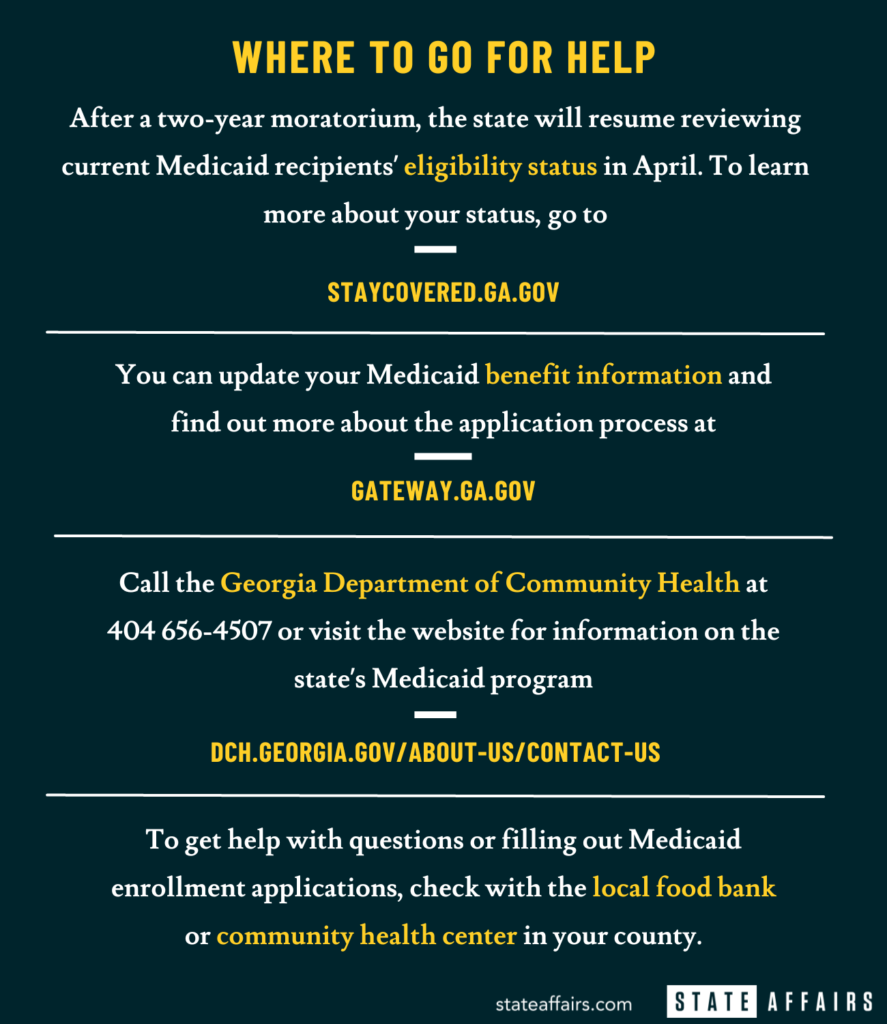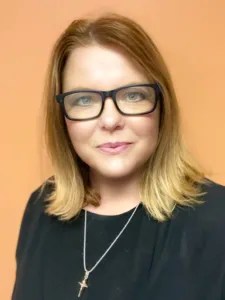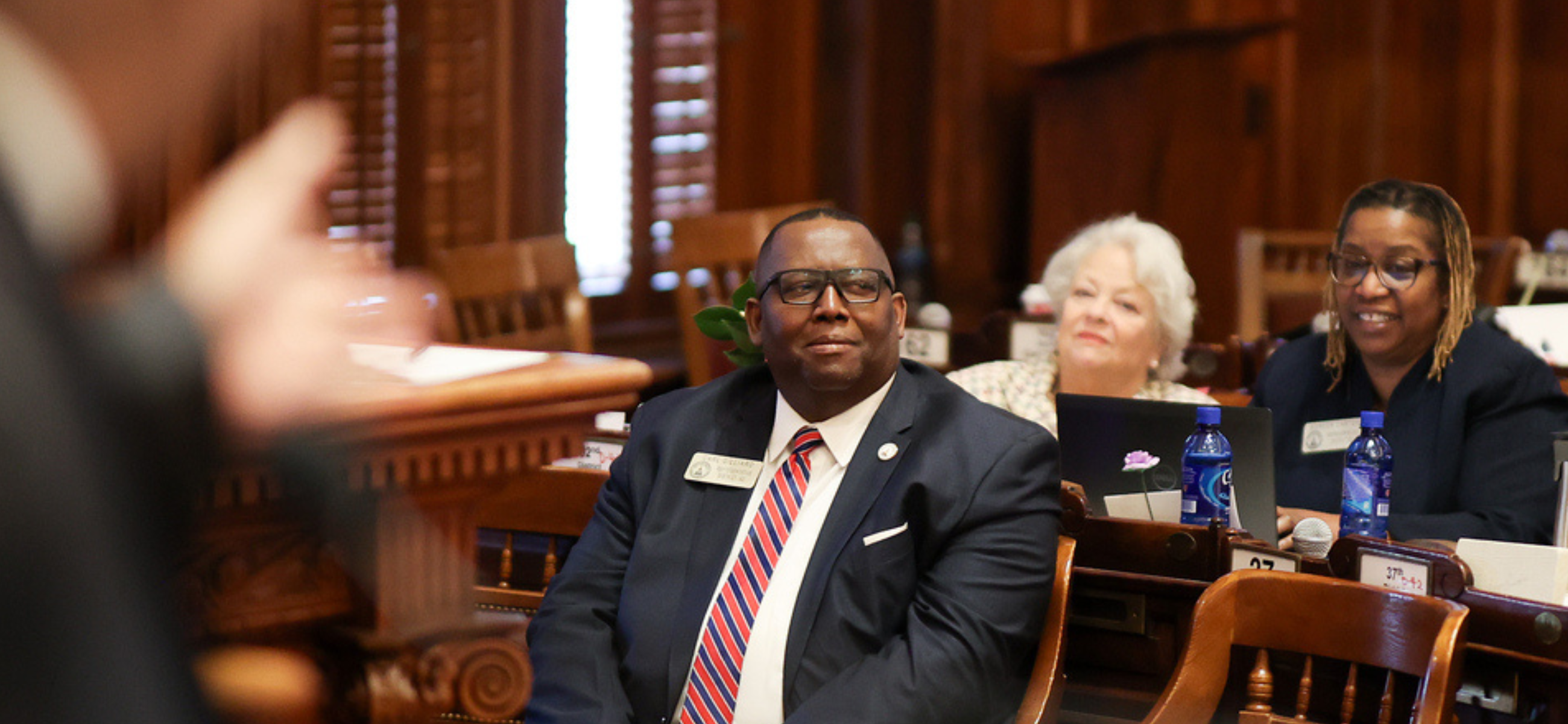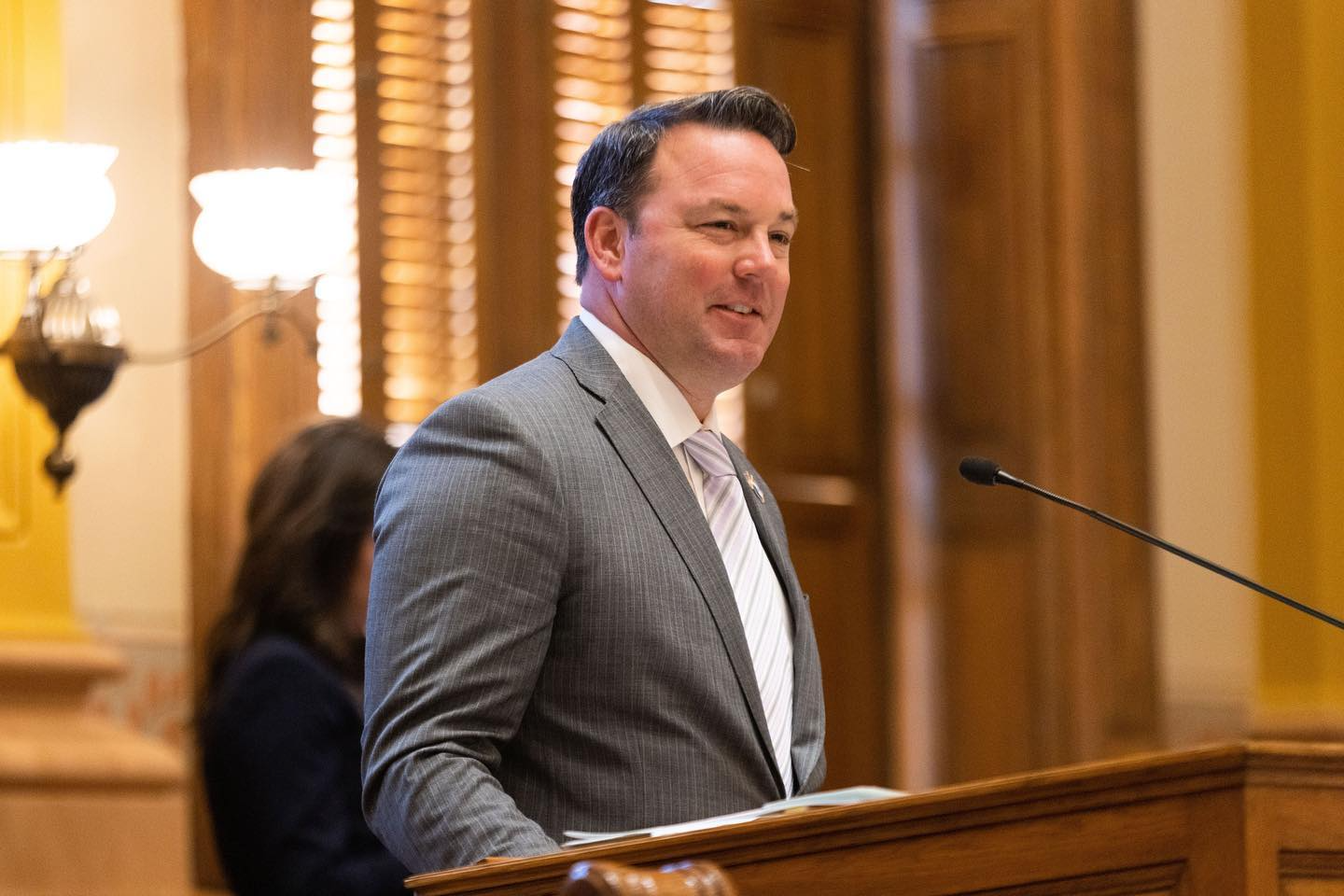Stay ahead of the curve as a political insider with deep policy analysis, daily briefings and policy-shaping tools.
Request a DemoState’s ‘Pathways’ Medicaid program set to begin July 1 amid continued controversy

The Gist
Gov. Brian Kemp is holding firm to his pledge not to expand Medicaid to hundreds of thousands of low-income Georgians. Instead, the second-term governor is touting a work-for-Medicaid plan that will require low-income individuals to complete 80 hours a month of work, school or volunteering to qualify for the benefit.
The plan is unique to the Peach State, and it is not without controversy.
The so-called “Georgia Pathways to Coverage” plan is slated to begin July 1, making Georgia the only state in the country to have work requirements tied to Medicaid coverage.
What’s Happening
Georgia officials have spent more than a decade debating the pros and cons of expanding Medicaid benefits to more Georgians, making it one of the most contentious issues in state politics today, often split along ideological and political party lines.
Georgia currently is one of 12 states that have opted not to extend Medicaid to more low-income people. The expansion plan was introduced in 2010 as part of the federal Affordable Care Act to broaden Medicare health insurance to include previously ineligible Georgians such as adults without children and those making just under the required amount to qualify for the aid.
“Here in Georgia, we’re taking an innovative and sustainable approach,” Kemp said in his annual State of the State address last week. “The Georgia Pathways to Coverage program was negotiated in good faith with the federal government so that we could expand access to health insurance for those who need it the most, while also sustaining the quality of coverage.”
At the start of 2022, Georgia sued the Biden administration, which refused to grant Georgia permission to force a work requirement as a condition to receiving Medicaid, which had previously been approved under former president Donald Trump. After several meetings, public hearings and other discussions, the federal government approved Pathways just before Christmas 2021.
Pathways supporters say the program will better regulate the number of Georgians receiving Medicaid, which in turn will mean better care for patients since the system won’t be overloaded.
“I think it's in the right direction,” said Steve Brown of Peachtree City who believes most federal money and programs have “strings attached.” Medicaid is funded by a combination of federal and state dollars.
Brown referred to the Pathway program as “a good start.
“And generally [federal funding] means that states are going to end up picking up the tab at some point when the federal government stops paying,” added Brown. “Can the state afford to take on the full burden of whatever they’re offering?”
An estimated 345,000 previously ineligible Georgians are expected to become eligible for Medicaid under the Pathways plan. Some people will pay monthly premiums, which will range from $7 to $16, depending on income and tobacco use.
Critics of Pathway argue that Medicaid is a more commonsense approach to providing health care coverage to hundreds of thousands more Georgians and that it’s more cost-effective than Pathway.
Georgia has spent over $15.3 billion on Medicaid since 2018, Kemp said during his address last week. “... While the state spends more and more, Georgians aren’t seeing an improvement in care they receive.”
Currently, Medicaid is available to Georgians who meet a variety of criteria. If your household income is at or below the current 133% of FPL you’re likely to be eligible for Medicaid. The FPL for 2023 was $14,580 a year for a single person, $19,720 for two people, and $30,000 for a family of four.
An estimated 1.3 million Georgians are uninsured, and Georgia’s uninsured rate of 13.7% is third-highest in the nation. That rate is expected to climb to 1 in 4 uninsured Georgians in rural Georgia by 2026, according to the Georgia Budget and Policy Institute (GBPI).
Medicare vs. Medicaid
Medicare is federal health insurance for anyone over the age of 65. It’s also for some under 65 who may have a disability or condition. A federal agency called the Centers for Medicare & Medicaid Services runs Medicare. Medicare has set standards for costs and coverage which means a person’s Medicare coverage is the same no matter what state they live in. For details, go to medicare.gov.
Medicaid is a joint federal and state program that provides health care insurance to people with limited income and resources. The federal government has general rules that all state Medicaid programs must follow, but each state runs its own program. This means eligibility requirements and benefits can vary from state to state. Medicaid offers benefits that Medicare doesn’t normally cover, like nursing home care and personal care services. People with Medicaid usually don’t pay anything for covered medical expenses but may owe a small co-payment for some items or services. For details, visit medicaid.gov.
Source: HHS.gov
Georgians Remain Divided
Ellenwood resident Pat Pullar is among many troubled by the Pathways to Coverage plan, noting that it “sounds like welfare-to-work.
“Welfare-to-work was for able-bodied people to get a stipend based on their work for the state. I didn't see that as a problem,” said the retired political consultant. But for Medicaid, “It’s almost like ‘if you don't work, you're not going to get health care. It just doesn't make any sense. We should have some more compassion for people who can’t afford health care,” said Pullar.
“[Georgia’s got] billions of dollars in surplus that you don't even know what to do with,” said Pullar, referring to nearly $12 billion in Revenue Shortfall Reserve and unreserved, undesignated surplus in state coffers. “But you want people to work for Medicaid.”
Signed into law 58 years ago by President Lyndon B. Johnson to provide health insurance coverage to low-income and disabled Americans, Medicaid has become a contentious and divisive issue in Georgia where lawmakers have repeatedly opted not to bring more Georgians into the program.
Full expansion of Medicaid would bring in more federal dollars that offset costs to the state, some argue.
“It could bring millions in both federal dollars and increased state and local tax revenue, and thousands of new jobs to our state,” Leah Chan, senior health analyst at GBPI told State Affairs. The Pathways program creates “unnecessary barriers,” especially for full-time caregivers and disabled veterans, Chan added.“Fully expanding Medicaid is the best choice for Georgia’s families and the state’s bottom line. The Pathways plan covers fewer Georgians and costs substantially more for the state to implement than a fully expanded Medicaid program,” Chan said.
According to a GBPI analysis of Pathways and Medicaid, the Pathways program would cost about $2,420 per enrollee in the first year compared to about $496 per enrollee under full Medicaid expansion.
Medicaid would enable more people of color, Georgians between the ages of 19 and 34, and those living in rural areas as well as the southern and western parts of the state to get coverage, Chan noted.
But public policy analyst Kyle Wingfield said the Medicaid system is broken and in need of an overhaul.
Wingfield cited the Washington, D.C. think tank Urban Institute’s projections on what a full Medicaid expansion would mean to Georgia if, for instance, it occurred this year.
It would add 739,000 Georgians to the program, cutting the ranks of the uninsured by 448,000.
“This means 291,000 or almost 40% of the potential new enrollees are people who already have insurance,” said Wingfield, president and CEO of the Atlanta-based conservative think tank Georgia Public Policy Foundation. “That’s a key fact that expansion proponents typically overlook and a key reason why expansion would likely cost far more than they allow.”
Wingfield said a Georgia expansion would cost federal taxpayers an additional $3.631 billion and Georgia taxpayers an additional $356 million.
“That means the total first-year cost of expansion would be almost $4 billion — or $8,900 per person who goes from being uninsured to insured,” Wingfield added. “Including those who would simply switch from private insurance to Medicaid, it would be about $5,400. This is a hugely inefficient way to expand a program that already fails to be cost-efficient.”
Medicaid in Georgia: By the Numbers
In July, Georgia will become the only state in America with a work-for-Medicaid program. Here’s a look at the Medicaid environment in Georgia:
- Georgians enrolled in Medicaid:* 2.7 million
- Georgians who are low-income: 32%
- Georgians on Medicaid: 18%
- Georgians who get Medicaid or PeachCare: 1 in 5
- Georgians between the ages of 19 and 64 covered by Medicaid: 1 in 11
- Children with Medicaid coverage: 3 in 8
- Nursing home residents with Medicaid: 5 in 7
- Non-elderly Medicaid recipients who are people of color: 68%
- Adults on Medicaid who are working: 56%
- Births covered by Medicaid: 47%
*Data from Georgians for a Healthy Future.
Source: Georgians for a Healthy Future, Kaiser Family Foundation, October 2022; Georgia Budget & Policy Institute
Why It Matters
In April, the state will begin reviewing who’s eligible — and who’s not — for Medicaid after a nearly three-year moratorium due to the pandemic. That review process will include many, if not most, of the roughly 2.7 million people currently receiving Medicaid in Georgia, according to Laura Colbert, executive director of Georgians for a Healthy Future, an Atlanta-based nonprofit consumer advocacy group.
The process is expected to take a year to complete and comes as the state gets ready to roll out the Pathways program in July. Medicaid eligibility is tied to income/poverty level. In Georgia, a person earning less than $14,580 a year and a family of four earning less than $30,000 a year would be eligible. A Kaiser Family Foundation report looking at Medicaid recipients and work requirements in comparison to welfare-to-work programs found that Medicaid recipients “often face barriers to employment, similar to those experienced by [welfare] enrollees.” Those barriers include physical or mental health disabilities, addiction, limited education, people whose first language isn’t English, and lack of affordable and reliable child care or transportation, the report said.
Most Medicaid recipients Stockbridge resident Emma Davis Hamilton knows aren’t able to work.
“Why is he [Kemp] doing things that are so contradictory to health care and that primarily affects African American and even poor working whites? He’s making it much tougher for poor people,” the retired military officer told State Affairs.
Colbert, of Georgians for a Healthy Future, said Georgia’s current Medicaid system shuts many people who need health care coverage out of the system.
“Georgia has a very stringent Medicaid program,” Colbert noted. “ Our program is one of the least generous programs in the country. The governor has put forth this program for those folks who fall in a coverage gap because Georgia has not expanded Medicaid. For those folks who fall in that gap, this program is going to be very difficult to get in and stay enrolled in.”
Colbert said those folks who fall through the gap generally are Georgians between the ages of 18 and 40; people in rural areas and other places where higher-paying jobs are scarce; workers in low-paying fields such as food service, grocery, retail and childcare; people with mental health and substance abuse conditions; and people of color. Blacks and Latino account for half of the people in Georgia’s Medicaid coverage gap, said Colbert.
What’s Next?
Pathways, the litmus test for how Georgia extends much-needed medical care to residents, is five months away from its debut and will be closely watched.
“I’m eager to see whether the Kemp administration is right, that there's a better way to administer Medicaid, because Medicaid is a program badly in need of reform,” Wingfield said. “If we're ever going to reform it, we need to see states trying new things and pioneering better ways to administer the program. If Georgia can be a leader in that, that would be really exciting.”

You can reach Tammy Joyner on Twitter @LVJOYNER or at [email protected]. Joyner is State Affairs’ senior investigative reporter in Georgia. A Georgia transplant, she has lived in the Peach State for nearly 29 years.
Twitter @STATEAFFAIRSGA | @STATEAFFAIRSIN
Facebook @STATEAFFAIRSUS | @STATEAFFAIRSIN
Instagram @STATEAFFAIRSGA | @STATEAFFAIRSIN
LinkedIn @STATEAFFAIRS
Header image: A woman receives a flu shot at a health clinic. (Credit: Brandon Smith for CDC)
Read this story for free.
Create AccountRead this story for free
By submitting your information, you agree to the Terms of Service and acknowledge our Privacy Policy.
Barbershop talks and hip-hop summits: Georgia Black legislators’ group has big plans to build coalitions, boost voter rolls
The nation’s largest gathering of Black lawmakers is slated to meet in Atlanta this summer to discuss ways to boost voter participation nationwide ahead of the upcoming fall elections.
The Aug. 2-4 conference theme is “Testing 1, 2, 3.” The meeting will be the precursor to a series of events the Georgia Legislative Black Caucus plans to hold heading into the November presidential election.
“Because we’re the largest Black caucus in the nation, we’re reaching out to all of the caucuses from across the nation,” Rep. Carl Gilliard, D-Savannah, chairman of the 74-member Georgia caucus, told State Affairs. “This is the first time that I think we’re doing a total reach-out to all of the Black caucuses. We share a lot of similarities. Whether it’s voter suppression in Georgia, the same laws are going to be tried in Tennessee and the same laws are going to be tried in Florida. We share a lot of commonalities.”
Next week, for instance, the Georgia caucus is scheduled to issue a statement supporting efforts to pass a hate crimes bill in South Carolina. The bill passed in the House but stalled in the Senate, Gilliard noted.
Over 700 Black legislators represent about 60 million Americans, according to the National Black Caucus of State Legislators. In addition to the Georgia caucus, Black caucuses exist in nearly three dozen states.
Shortly after the August convention, the Georgia Legislative Black Caucus will embark on a 14-city tour throughout Georgia to focus on “getting out the vote.”
“We’re not going to tell them who to vote for,” Gilliard said of voters. “But what is happening right now is no one is talking to the people. And if the election were held today, we all would be in trouble because no one is talking or meeting the people where they’re at.”
The tour is a continuation of various actions the Georgia Legislative Black Caucus has taken this year to align with other organizations of people of color on common causes.
In March, the caucus joined forces with the Asian American Pacific Islander and Hispanic caucuses for a tri-caucus town hall. It was the first time the three groups have aligned. The Black caucus also has “reached out to partner with the Hindus of North America population and the diaspora,” Gilliard said.
“What we’re trying to do is form a coalition to get to as many diverse groups of people as we can,” he said.
Gilliard said the lack of individual and collective involvement in communities he’s seeing concerns him. It’s a far cry from four years ago.
In 2020, the deaths of Ahmaud Arbery, an unarmed Black man murdered while jogging in Glynn County, and Breonna Taylor, a Black woman killed by Louisville, Kentucky police serving a no-knock warrant for drug suspicion, led to more than 450 protests nationwide and on three continents.
That same year, former Georgia gubernatorial candidate Stacey Abrams led an effort to increase the voter rolls for the 2020 presidential election. Fair Fight and the New Georgia Projects, two groups Abrams founded, registered more than 800,000 new voters.
That level of community and political engagement has since subsided, Gilliard said.
“People don’t know what’s going on,” Gilliard said. “No one is really talking to the people. You’ve got a presidential election. I’m talking about on both [political] sides. There are rallies and different events being held, but nobody has gone to the barbershop. No one has gone to the community centers or the neighborhoods. We’re going to be empowering those communities by going and taking those townhall meetings right where they’re at, not in a big municipality but in community centers and neighborhoods.”
The caucus also plans to hold a hip-hop summit to reach young people, many of whom are skeptical of both political parties.
“They’re forming their own opinions,” Gilliard said. “They’re saying, ‘Forget about Trump. We need to hear something different.’ That’s just their perception. That’s why I’m really quietly championing the young candidates behind the scenes who are running right now because we need young leaders.
“We have to get as many people together, but we also have to get them ready to work.”
Have questions, comments or tips? Contact Tammy Joyner on X @lvjoyner or at [email protected].
And subscribe to State Affairs so you do not miss any news you need to know.
X @StateAffairsGA
Instagram@StateAffairsGA
Facebook @StateAffairsGA
LinkedIn @StateAffairs
Special prosecutor to decide if Lt. Gov. Jones should face criminal charges in 2020 election-meddling case
Lt. Gov. Burt Jones will face scrutiny over whether he should be criminally charged for alleged meddling in the 2020 presidential election in Georgia.
The Prosecuting Attorneys’ Council of Georgia said Thursday it has assigned Executive Director Pete Skandalakis as the special prosecutor to handle the case because Fulton County District Attorney Fani Willis is barred from investigating Jones. The council is a nonpartisan state advocacy agency for district attorneys.
In July 2022, Superior Court Judge Robert McBurney blocked Willis from investigating Jones because her actions were an “actual and untenable” conflict of interest. At the time, Willis had hosted a campaign fundraiser for Jones’ Democratic rival, Charlie Bailey, and donated to his campaign when both men were running for lieutenant governor. Willis is currently involved in an election interference case she brought against former President Donald Trump and 18 others.
McBurney’s ruling left it up to the council to decide whether Jones should be criminally charged.
“I’m happy to see this process move forward and look forward to the opportunity to get this charade behind me,” Jones said in a statement issued Thursday. “Fani Willis has made a mockery of this legal process, as she tends to do. I look forward to a quick resolution and moving forward with the business of the state of Georgia.”
The council cited state bar rules in its news release and said there would be no further comments.
Skandalakis’ appointment marks another step in the ongoing political odyssey for Jones and other lawmakers over charges that they served as “false” electors to help Trump overturn the 2020 presidential election in Georgia.
Jones is one of 16 alleged “false” electors in Georgia who gathered at the state capitol on Dec. 14, 2020, to cast ballots for Trump and then sent their false certification of his victory to the National Archives and the governor’s office.
Jones has denied any wrongdoing, saying he and other electors were acting on the advice of lawyers to preserve Trump’s chances in Georgia in case the former president won a court challenge that was pending at the time. Jones was a state senator during the 2020 election.
Trump’s campaign enlisted an alternate slate of electors in 2020 in a number of swing states where Trump was defeated, as part of an effort to circumvent the outcome of the voting, The New York Times reported Thursday.
Have questions? Contact Tammy Joyner on X @lvjoyner or at [email protected].
And subscribe to State Affairs so you do not miss any news you need to know.
X @StateAffairsGA
Facebook @StateAffairsGA
Instagram @StateAffairsGA
LinkedIn @StateAffairs
Georgia taxpayers get a tax credit for helping young adults leaving foster care
The Gist
Georgia lawmakers in 2022 laid the groundwork to help young adults leaving the foster care system get a good start in life while giving taxpayers another tax relief option.
At that time, the Georgia General Assembly passed House Bill 424, also known as the Fostering Success Act. This law created the Qualified Foster Child Donation Credit program. It’s a tax credit plan that allows taxpayers to redirect their state income tax dollars to qualified organizations providing support services to young adults transitioning out of foster care.
Capped at $20 million a year, the money is used to help young adults ages 18 to 25 once they leave foster care.
What’s Happening
The tax credit took effect in 2023. The number of qualified organizations participating in the program has nearly doubled to 39 this year from 20 last year.
A bill to increase the cap on the tax credit to $30 million a year failed during this year’s legislative session because the House and Senate couldn’t agree on whether to expand the annual cap. It remains at $20 million a year.
As of March 28, $153,000 of the $20 million fund has been approved for the 2024 tax year. Roughly $19.8 million remains.
“With this being the second year of the tax credit, this tax credit opportunity is still relatively new and unknown,” Heidi Carr, executive director of Fostering Success Act Inc., told State Affairs. “It takes a while to get the awareness around it up.”
Carr’s group is one of the qualified organizations participating in the tax credit program. The nonprofit is not connected to the government program.
Georgia taxpayers get a dollar credit for every dollar they donate to a qualified organization, up to a certain amount. Here’s how it works:
- An individual or business applies through the Georgia Department of Revenue to qualify for the tax credit. The taxpayer specifies how much to donate and which organization will get the donation.
- Once approved, the taxpayer makes a payment directly to the organization.
- When the organization receives the payment, it sends the taxpayer the documents required when filing their state tax return so they can get their tax credit. The organization also notifies the state of the transaction.
Why It Matters
Each year, more than 700 young adults leave the foster care system in Georgia. They are some of the most underserved and overlooked people in the foster care system. Many never return to their biological families or get adopted. Once they leave the system, they often have little to no guidance as they enter college or the workforce.
The fostering success funds will help those young people with education, housing, counseling, medical care and transportation services.

Money generated from the tax credit has enabled Connections Homes to help 20 young people so far this year, Founder and Chief Executive Officer Pam Parish told State Affairs.
The Alpharetta-based nonprofit’s main goal is matching young people who have left or are leaving foster care with mentoring families. However, the $20,000 received through the tax credit program allows the organization to do much more, Parish said.
In one instance, they helped a young mother of two in her early 20s who is attending college and dealing with cancer. The organization paid the former foster care youth’s rent and car note and was able to “do the things that we could worry about and let her worry about getting better and staying in school,” Parish said.
Without the money generated through the Fostering Success Act’s tax credit program, such help would have been a “funding struggle,” Parish added.
“Our main program is our mentorship, which is immensely helpful to our kids,” she said. “But really to get into these practical needs and [having] funding available to do that is really helpful for our organization but most importantly for these kids.”
The organization has helped some 350 foster youth in its 10-year existence, Parish said. She and her husband have eight daughters, seven of them adopted. Five became part of the family after the age of 18 due to various circumstances, including surviving trafficking, homelessness and aging out of foster care, she said.
Similarly, Wellroot Family Services has been able to help foster youth pursuing college degrees.
“The Fostering Success Tax Credit bolsters the housing and wraparound services we provide for those youth pursuing postsecondary education and has enabled us to provide scholarships to former foster youth,” Wellroot CEO Allison Ashe said. “Because of the tax credit and the generosity of donors, we were able to provide additional funds to some of the youth pursuing college degrees to use for books and other academic supplies.”
What’s Next?
It’s not too late to participate in the 2024 tax credit program. To qualify, taxpayers must get the state’s approval and make their payments within 60 days of being approved or by Dec. 31, whichever comes first.
Between January 1 and June 30, the following yearly contribution limits are based on the taxpayer’s filing status:
- Single individual or head of household: Up to $2,500
- Married filing jointly: Up to $5,000
- Individual owner of an S corporation, member of an LLC or partner in a partnership: Up to $5,000
- C corporation, trust, or pass-through entity electing to pay tax at entity level: Up to 10% of Georgia income tax liability
Learn more about the Fostering Success Tax Credit here. As with any tax matter, consult your tax adviser. You can find a list of certified foster child support organizations on the Department of Revenue website.
Read these related stories:
Have questions? Contact Tammy Joyner on X @lvjoyner or at [email protected].
And subscribe to State Affairs so you do not miss any news you need to know.
X @StateAffairsGA
Facebook @StateAffairsGA
Instagram @StateAffairsGA
LinkedIn @StateAffairs
Special election runoff for House seat in Columbus may be dress rehearsal for general election
ATLANTA — Two Georgia Republicans who virtually tied in a special election held Tuesday to fill the Columbus-area seat of the late state Rep. Richard Smith, will now compete in a May 7 runoff.
Sean Knox, who heads a pest control company, won only 12 more votes than Carmen Rice, a corporate administrator who’s the former chair of the Muscogee County Republican Party. Each received about 42% of 2,455 votes, finishing far ahead of Republican Donald Moeller, a dentist and oral surgeon; and independent Robert Mallard, a real estate broker. Neither Knox nor Rice earned a majority of votes to avoid a runoff.
The winner of the runoff will represent Smith’s House District 139, which covers parts of Muscogee and Harris counties, through the rest of this year and until Jan. 13. Smith died Jan. 30.
Knox and Rice also are vying to represent the Columbus district for a full two-year term beginning in January 2025, for which they’ll have to compete again with Moeller, who qualified for the May 21 primary. The Republican who emerges victorious in that race will compete with Mallard in the general election in November, along with Democrat Carl Sprayberry, a chef from Muscogee who has no primary challenger.
So, who are the two GOP front-runners hoping to replace Smith, who served in the House for nearly 20 years, rising to the powerful position of Rules Committee chair, and used his clout to bring back considerable resources to his home district?

Knox, a third-generation leader of his family’s Columbus-based pest control company, has campaigned on his business acumen and deep community connections. A Columbus native, he has served on the boards of a Boys & Girls Club in Columbus, the Columbus Convention and Trade Center, and the Georgia Chamber of Commerce.
His campaign website indicates he supports job creation, economic growth and low taxes. During the special election campaign, Knox told local reporters that he, like Smith, is for small government.
“Richard was passionate about limited government but smart government and how government can help the state and the community that it serves, and Columbus benefited from his leadership,” Knox told WVTM-TV. “I will just do the best I can to continue that legacy.”

Rice, an administrative director with a background in food franchising, was the first woman elected as Republican Party chair in Muscogee County last year. She hosted former President Donald Trump and U.S. Rep. Marjorie Taylor Greene, the conservative firebrand who represents District 14 in northwest Georgia, as headliners at the state GOP convention in Columbus last June.
A self-described America First candidate, Rice is running on a platform that includes supporting public safety and law enforcement, education (including school choice and more funding for teachers), stricter border control, transportation and economic growth. Part of that economic growth includes the proposed $5 billion Interstate 14 project that would run from Texas through Georgia, with a leg stretching from Columbus to Augusta. The state transportation department so far has dismissed the project as too expensive.
“As a former foster parent, I am committed to furthering foster and adoption care reform, ensuring the well-being of vulnerable members of our community,” Rice stated on her campaign website. She’s also for “efficient, effective and limited” government.
Rice is an avid supporter of Trump and his second presidential campaign, and has echoed his claims of political persecution related to the several criminal cases and civil suits he’s faced over the past two years.

Moeller, a part-time oral surgeon and the third Republican candidate in both District 139 elections, received 6% of the vote in Tuesday’s special election. If elected to the Statehouse, he vowed to focus on “the Georgia budget” and constituents’ health care and educational needs. “We’re losing our nurses and teachers,” he said.
Also a proponent of the America First agenda, Moeller said he values free markets, lower taxes, eliminating burdensome regulations that stifle economic growth, border control that protects national security and economic interests, and defending gun rights.
Noting he served in the military for 10 years and “attended two wars,” he’s also sensitive to the needs of veterans, including those with post-traumatic stress disorder. A former college professor in health sciences, Moeller said he has engaged in “research in neuroscience and bioengineering to stop PTSD.”

The independent candidate Mallard, who got nearly 10% of the vote on Tuesday, is an Army veteran who served multiple tours in Iraq and works as a real estate broker. He and his wife, also an Army vet, run a nonprofit that engages youth, seniors and veterans in beekeeping and other therapeutic services to promote self-sufficiency.
Mallard wants to add more high-paying trades and technical certifications to the education system and develop programs for young adults emphasizing business and entrepreneurship “that opens their eyes to what’s possible, how things work and how they can build or support the economic engines that will keep putting food on their table and raising their standard of living.”
He supports gun rights, school choice, more resources for law enforcement and first responders, and secure borders, and says he’ll “work across the aisle” to find ways to address rising addiction rates among youth.

Democrat Sprayberry lost to then-incumbent Republican Smith in the 2020 general election for the same House seat, earning 36% of the vote. In 2022, he ran for the Columbus City Council and won 5% of the vote in a five-person race for an at-large seat.
The 31-year-old chef has an expired campaign website, but his recent posts on X emphasize his strong support of President Joe Biden’s economic policies, reproductive choice, gun control and government-subsidized health insurance. He’d also like the government to regulate social media sites such as TikTok and Facebook, which he said are engaging in “child exploitation.”
On March 3, Sprayberry posted a thread on X that said:
“My platform is basically the same as in 2020, with an emphasis on healthcare access, addressing rising insurance rates in the state, funding for mental health workers, working on addressing increased homelessness throughout the state, continuing efforts to lower crime rates, oversight on how federal infrastructure funds are being spent, and additionally, I would like to introduce an amendment to the state constitution to require any statewide office holder (governor, lt. gov, SoS, etc.) to step down before they could run for a federal office.”
The special election runoff for House District 139 will be May 7. The winner will serve until Jan. 13.
The 2024 election primary for all 236 General Assembly seats and other state offices will be held May 21.The general election, which includes state and federal races, including the presidential election, will happen Nov. 5.
The 2024 legislative session ended March 29, but lawmakers will continue to convene for committee meetings, interact with constituents and gather to strategize with political allies in the Legislature throughout the rest of the year.
Have questions or comments? Contact Jill Jordan Sieder on X @journalistajill or at [email protected]
And subscribe to State Affairs so you do not miss an update.
X @StateAffairsGA
Instagram @StateAffairsGA
Facebook @StateAffairsGA
LinkedIn @StateAffairs




